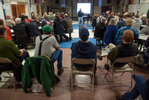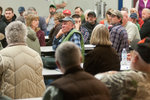

ONALASKA — Flooding is nothing new in Lewis County.
Properties from one end of the county to the other regularly find themselves in harm's way when area rivers run wild. Typically, though, it’s the unruly Chehalis and Cowlitz rivers that draw the bulk of the attention.
A public meeting hosted by the Lewis County Conservation District on Tuesday was meant to shift that focus to the unpredictable Newaukum River.
The meeting at the Onalaska elementary school gymnasium was attended by about 100 citizens who came with a wide array of concerns and suggestions to broach with the members of the Conservation District. The conservation officials came with an open ear and only interjected in the meeting to provide clarification or nuance when needed or requested.
Mostly, conservation officials used the opportunity to encourage landowners and managers to proactively undertake projects intended to prevent erosion during times of high water.
At the beginning of the meeting, Ray Ledgerwood, the district operations manager for the Washington State Conservation Commission, noted that “while there are a lot of people out there that will tell you what to do, the most lasting impacts come from the change you decide to make yourself.”
The Newaukum River watershed includes 166 miles of river that is inhabited by coho, cutthroat, steelhead, chinook and lamprey, just to name a few species. The river is a prized entity to those who make their home in its vicinity, but those same folks are often plagued by destruction that emanates from its powerful whims. Erosion problems along the Newaukum have increased significantly since major flood events in 2007 and 2009, and many area residents are unsure of what techniques are useful — or even what steps they are allowed to take — on their own property in an effort to shore up their shorelines.
Numerous ideas for flood control and property management were tossed out by members of the crowd during a brainstorming session, but those suggestions conflicted with each other on more than one occasion.
Some folks suggested leaving more wood debris in the river in order to act as a shoreline buffer and to keep essential nutrients and sediment in the river system. Others noted that too much wood in the river can cause problems as well when logjams divert water to new areas or create destructive eddies in the river current.
One option that found some middle ground was a suggestion to strap logs to the banks of the river with cable so that they would act as a shore buffer while still being able to sluff their detritus into the river as they rot.
That was not the only talk of trees however.
Many properties along the Newaukum River suffer from heavy, clay-based soils that do not drain rainwater or river runoff.
Numerous options for creating more permeable soils were discussed by conservation members and private citizens alike. Promoting vegetation growth along the waterfront and adjacent riparian areas was one popular method of land management proposed, since the root structure of the plants would act to hold the soils together while creating a more porous ground floor.
However, for landowners who are already staring down the barrel of the unrelenting river, the prospect of planting trees in order to hold their ground is typically unrealistic.
As one woman in the crowd asked, “How can you grow trees fast enough to keep the river from taking them?”
Stopping the rapid loss of property was understandably the key concern for most citizens in attendance on Tuesday. As a result some proposed ideas were more ecologically sensitive than others. While promoting vegetation along the river was one idea, others in the crowd wanted to take that idea a few steps further by using concrete or other types of riprap in especially precarious areas prone to erosion.
One of the problems with riprap, though, is that it speeds up the natural flow of the river and often creates even more problems downstream from the reinforced area.
As several members of the crowd noted, the use of riprap and other unnatural barriers also has a detrimental effect on fish and their wild spawning areas, so their implementation is typically a last ditch resort.
Gair H. Crutcher, a resident of Onalaska, was opposed to another common river flow mechanism — dams.
“We are talking about the future and I would like to state that I would like to see it (Newaukum River) remained undammed,” said Crutcher. “We moved here because we love nature and when you dam a river you lose a lot of that.”
That concern for fish and the natural esthetics of the river was a common theme of the evening. “Fish are a big icon in the Pacific Northwest and we want to keep them here,” said Bob Amrine, the Conservation District manager.
Mostly, though, the landowners in attendance were frustrated by the cumbersome and opaque permitting process required to make significant changes to their property adjacent to the river.
A general uncertainty for what steps are allowed and which ones require special permission was rampant in the room.
Some citizens called for the permit process to be streamlined through one department, or at least for the guidelines to be more clear.
In the words of one landowner, “A lot of people have applied for permits and have been denied. I think it would help a lot if instead of just saying, ‘no,’ they said, ‘no, but …’”
Others in the crowd expressed resentment for what they perceive as a callous government assigning the blame to them for their misfortune.
While some landowners have undoubtedly made poor decisions over the years when it comes to land management, that is not true across the board, they said.
Much of the land degradation that has unleashed the Newaukum in recent years was undertaken many generations ago.
“When early settlers came into this area they cleared a lot of land that they shouldn’t have and that’s what we’re dealing with now,” said Pete Murphy, of Onalaska. “I’ve made my mistakes and logged where I shouldn’t have and I’ve learned my lessons. I’ve become a lot more friendly as I’ve gotten older.”
After the meeting, Dave Finn, chairman of the Conservation District, said he was encouraged by the turnout and dialogue, but he remained skeptical that much real change will spring from the meeting in time to help landowners in danger of losing their homes or property.
“It gives people an opportunity to hear other people and their ideas,” said Finn, who cautiously added, “But it’s a long term process. When you’re talking planting trees, it’s a long process.”